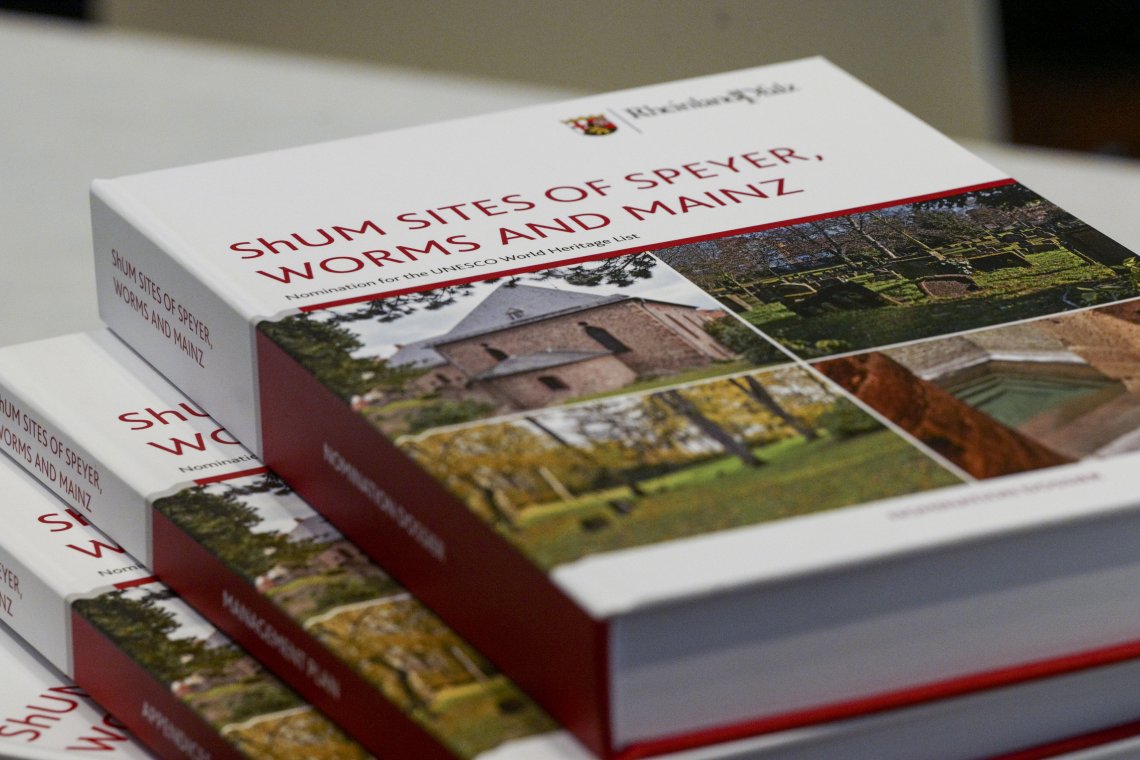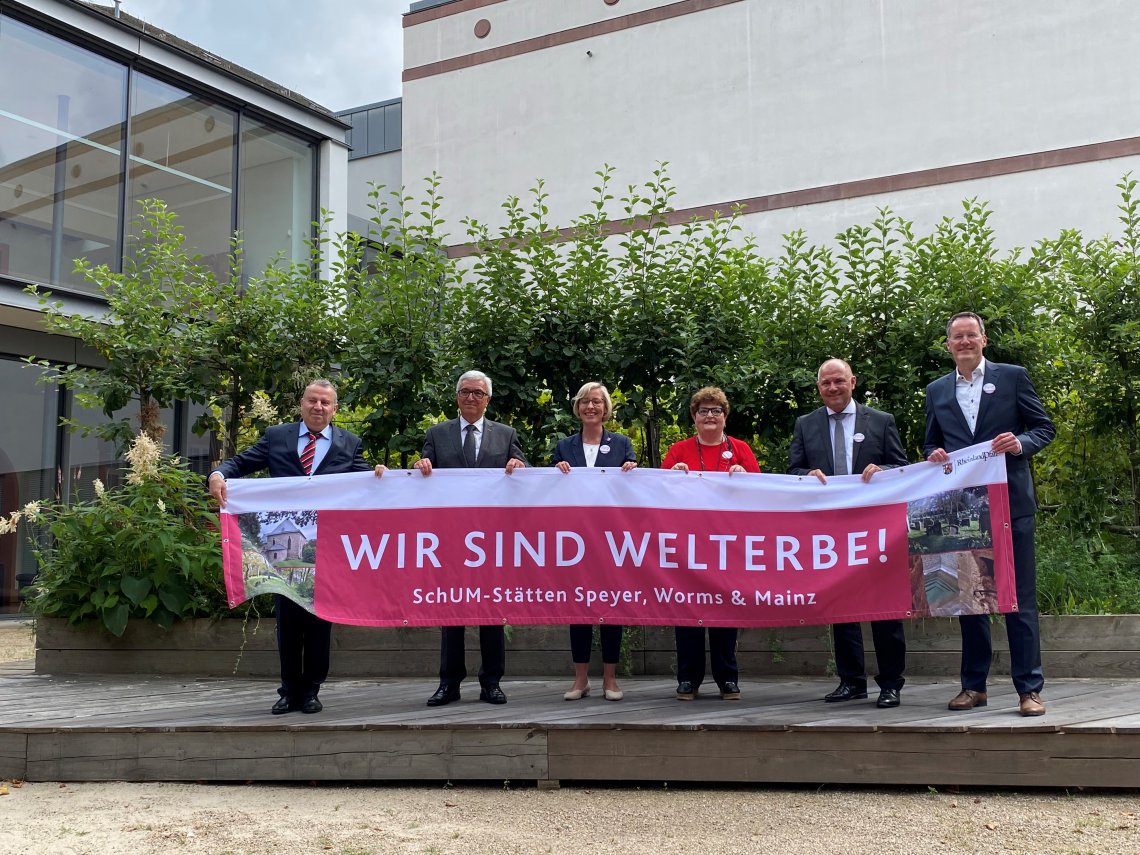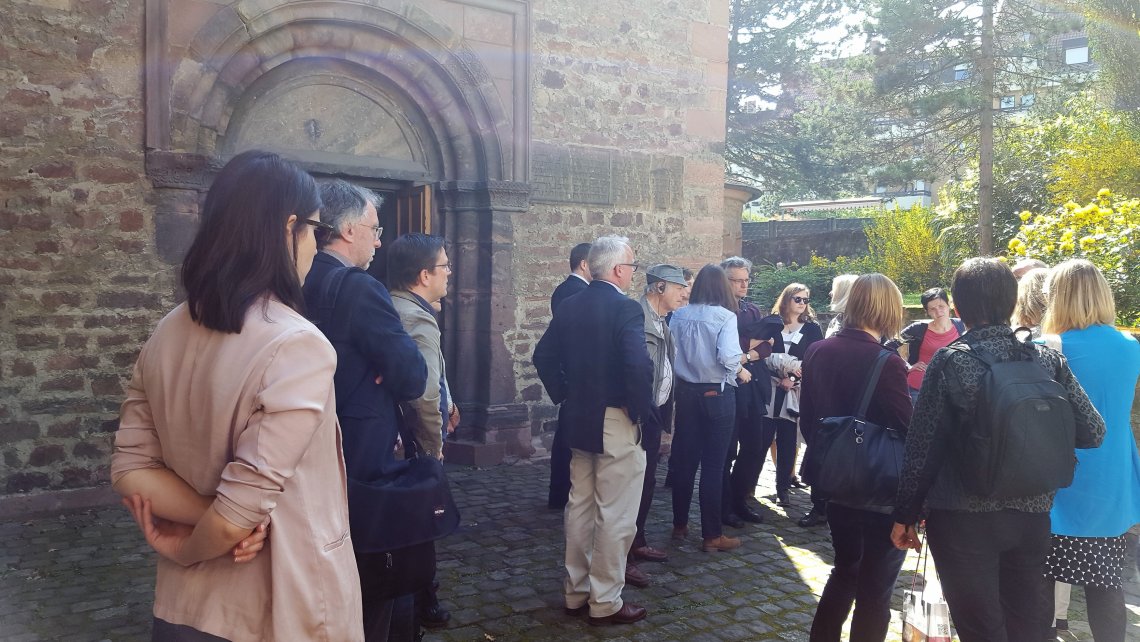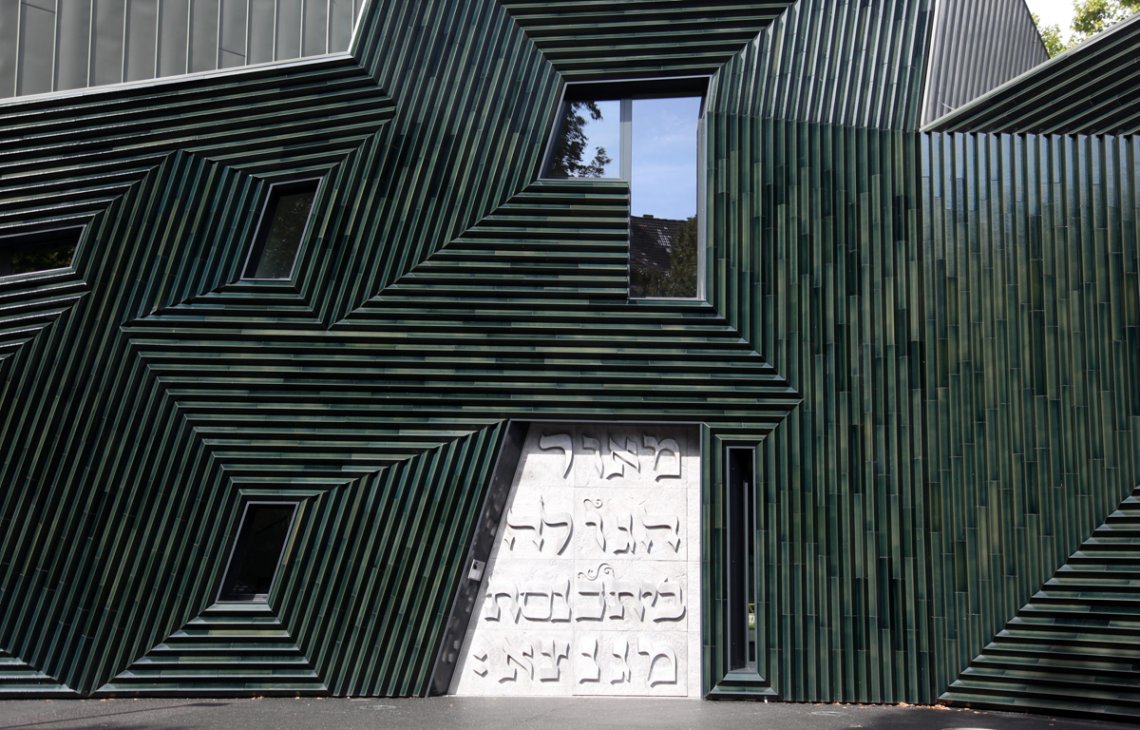ShUM-Sites Speyer, Worms and Mainz: The application
Nomination Dossier for UNESCO: Nomination and appendices
ShUM is UNESCO World heritage
"I am delighted from the bottom of my heart about this important decision by Unesco for our federal state: The ShUM-Sites of Speyer, Worms and Mainz are World Heritage Sites! This vote is invaluable for the cultural and historical diversity in Rhineland-Palatinate. The monuments of the ShUM cities are not only stone witnesses to an extraordinarily colourful Jewish history in our country, they also stand for the cultural transfer between Christianity and Judaism and remind us to see this as a common, great opportunity," said Minister President Malu Dreyer. She thanked all those who had worked on the World Heritage application and thus helped to create awareness of the comprehensive significance of the Jewish heritage.
"The recognition as a World Heritage Site underlines the importance of the ShUM-Sites of Speyer, Worms and Mainz as unique monuments to the thousand-year history of Jews north of the Alps. They are extraordinary testimonies of Christian-Jewish encounters. We are proud that this outstanding Jewish heritage is part of our cultural identity in Rhineland-Palatinate," said Roger Lewentz, the Interior Minister responsible for the state’s cultural heritage. "The recognition as a World Heritage Site will help ensure the protection and preservation of the monuments for future generations and keep alive the awareness of the long German-Jewish history with all its light and dark times," Lewentz said.
“This is a day of great joy. Often enough, when I took part in the meetings in recent years, I was able to witness for myself how much careful work and what enthusiasm is behind this application for recognition as a UNESCO World Heritage Site. I congratulate all those involved and all those responsible on their great success. Also on behalf of the community members, I express my gratitude and respect," said Anna Kischner, Chairwoman of the Jewish Community of Mainz and Worms. "The Jewish community is proud that we Jews can contribute to the worldwide reputation of Rhineland-Palatinate. May the tourists wonder in awe at the beauty of our culture in view of the medieval legacies, may they see the connections and become ambassadors not only for the medieval ShUM communities, but also for us, for the Jewish people who live here alongside the Rhine today," Kischner said.
"Speyer is delighted about the inclusion of the ShUM-Sites in the World Heritage List. They attest to centuries of intellectual, cultural and economic exchange between Christians and Jews that we can still build on today. We are particularly proud that 40 years after the Imperial Cathedral, a second World Heritage Site is now located to Speyer, highlighting the peaceful coexistence of different religions in our city," said Lord Mayor of Speyer, Stefanie Seiler.
"From today on, our city will be a different one: in it, the extensive Jewish heritage will once again become visible and alive. And not only for the Jewish world, where ShUM was always present, but for all mankind," emphasized Michael Ebling, Lord Mayor of the state capital Mainz. "The cultural monument with which the city of Mainz participated in the Unesco application is the Old Jewish Cemetery ‘Judensand’. Anyone who visits it can hardly escape its atmosphere. This unique place is now officially a World Heritage Site. It feels like it always was, because the cemetery on the ‘Judensand’ not only holds the oldest gravestones in Central Europe, it was also the largest of its kind in Ashkenaz at the time," says Ebling.
"Today, we can say with great pride that the city of Worms, along with Speyer and Mainz, is home to a Unesco World Heritage Site. This recognition means a lot to our city, because we have a high regard for the Jewish sites, the medieval community center with synagogue, the women’s shul, the mikveh and the former community center, as well as the old Jewish cemetery ‘Heiliger Sand’. The trust of the Jewish Community as the owner of almost all of these monuments has guided us in all questions and votes and determined our decisions. Unesco has now given these special sites an unparalleled tribute with the title of World Heritage Site," said Adolf Kessel, Lord Mayor of Worms.
The inscription of the SchUM sites in Speyer, Worms and Mainz on the World Heritage List recognizes the outstanding universal value of the SchUM sites with their synagogues, women’s shuln, mikvaot and cemeteries. The Unesco World Heritage Committee, a body of 21 elected representatives of the member states, justifies the inscription on the World Heritage List with the fact that the ShUM-Sites were setting an example for Jewish community centers and cemeteries whose form and design had a decisive influence on Jewish architecture, ritual buildings and burial culture throughout Central Europe north of the Alps, in northern France and England. In no other place we know about a comparable variety of Jewish community centers and cemeteries that bear witness to the cultural achievements of European Jews in the formation phase of the living tradition of Ashkenazi Judaism.
Joint media information of the Ministry of the Interior and Sports of the State of Rhineland-Palatinate and the cities of Speyer, Worms and Mainz dated July 27, 2021
ShUM - Criterias for application
UNESCO-Website on ShUM
The Outstanding Universal Value of the ShUM-Sites of Speyer, Worms and Mainz is based on the following values:
Influence on the development of architecture: Outstanding, landmark buildings and sites whose design significantly influenced Jewish ritual buildings and burial culture in Central Europe for several hundred years.
Testimony to a living tradition: Outstanding, especially early and in unique density and completeness surviving testimonies to the living tradition of "Ashkenazic Judaism".
Testimony of the process of urbanization: Outstanding testimonies of the participation of Jews in the process of urbanization north of the Alps during the 10th-13th centuries.
Testimony of encounter and/or violent persecution: Exceptional and meaningful evidence of the long history of Christian-Jewish encounter and violent persecution and were recognized early in their importance and treated as high-ranking memorial sites.
Center of religious intellectual life: ShUM offers tangible evidence of the cradle of Ashkenazi Judaism. Scholars, poets, and community leaders in Mainz, Worms, and Speyer played leading roles in the formation of this tradition during the 10th to 13th centuries. Their self-image as »holy congregations« is reflected in common statutes (the Takkanot ShUM), in works on religious law and ethics, and in liturgical poetry. All of these writings remain part of Jewish tradition to this day.
Proof of exceptional universal value also includes the conditions of intactness (integrity) and authenticity. In this context, integrity is a measure of the completeness and intactness of the features of the nominated World Heritage Site that have Outstanding Universal Value.
The ShUM-Sites of Speyer Worms and Mainz meet the condition of integrity because ...
... the serial nomination represents the closely interwoven cultural tradition of the Kehillot SchUM in the three cities of Speyer, Worms and Mainz.
... the boundaries of the estate largely follow those of the original incidents.
... the appropriate size of the estate ensures the full reproduction of the features that convey the overall significance of the SchUM sites of Speyer, Worms and Mainz.
... none of the components is threatened by adverse effects from urban development or neglect.
Historic authenticity expresses the relationship between features and outstanding universal value. The condition can be considered met when cultural value is expressed through a variety of features. The ShUM-Sites of Speyer Worms and Mainz fulfill the aspect of authenticity because ...
... the basic arrangement, the spatial division and the respective contexts in interaction with the architectural form reflect their significant and influential development in the High Middle Ages in a clear and incomparable way.
... they are well preserved according to their historically evolved character from the 11th to the 14th century, with additions in the 17th century and interventions in the 20th century, and have retained their authenticity in all aspects.
... salvaged material has been reused for necessary repairs for centuries.
... the synagogue and adjacent buildings in the Worms synagogue district, which were set on fire in November 1938, unlike other ritual buildings, were carefully recovered and, where necessary, reconstructed in accordance with extensively available documentation. The recovery, in the context of deliberate and systematic destruction of cultural heritage is therefore a fundamental conservation measure was to protect the material values and associated intangible practices and beliefs. It is an absolutely exceptional case, where the reconstruction is justified on the basis of conservation guidelines still in force today.
... an awareness of the significance of the nominated property had already existed since the High Middle Ages, and the components and their elements had been scientifically studied since the middle of the 18th century, and their significance increasingly recognized. Existing and ongoing documentation is comprehensive and research is ongoing.
The ShUM-Sites fulfill the requirements for protection and management; the central protection instrument is the monument protection law of the state of Rhineland-Palatinate. The ShUM-Sites enjoy the greatest possible legal protection through their protected status. In addition, the legal foundations of urban and state planning as well as municipal legal ordinances and bylaws ensure additional effective protection of the nominated property. To ensure that the Outstanding Universal Value of the nominated ShUM-Sites are preserved for future generations, and to ensure protection as well as integrated and coordinated management, a management plan has been developed. The management plan details the measures to be implemented on an ongoing basis as well as priority projects. The management plan explains the plans for education and outreach concepts as well as for responsible visitor management and for a sustainable tourism concept.
ShUM - more than Monuments and cemeteries
ShUM as World Heritage
The ShUM sites are of central importance to Judaism and Jews worldwide and are recognized as significant Jewish heritage also in the non-Jewish world.
ShUM are mikvaot and synagogues, women's shuls and teaching houses, and cemeteries. ShUM are scholars, knowledge and tradition. At the same time, the history and tradition of these three cities and their Jewish sites also reflect how Jewish community life and scholarship developed in the midst of the Christian majority society, but was also repeatedly inhibited or even destroyed. ShUM means coexistence and exchange, togetherness and coexistence, flourishing and also decline through expulsions and murders. Jews have contributed to social and religious, economic and social discussions and developments, but also to culture, architecture, law and other disciplines in SchUM. SchUM was like a Jewish house of learning in many buildings and three locations, whose significance transcended the specific sites. The anti-Jewish pogroms and persecutions leading up to the Shoah also left deep imprints - and yet bridges were built over these trenches to care for and preserve the common heritage and convey its value to posterity.
UNESCO wants the listed World Heritage Site to represent the world in its diversity. The ShUM sites connect Jewish with European with global history, they are significant for Jews and non-Jews worldwide. The monuments are outstanding and serve as spaces of remembrance as well as for one's own self-location in the present.
SchUM offers space for reflection.
ShUM leaves us with central questions also for the present:
- How can and should different cultures and religions live together without giving up their own roots? How does coexistence work? Assimilation or acculturation?
- How is it possible to live again side by side as neighbors after pogroms, destruction and expulsions?
- What do centuries-old comments of a Rashi mean e.g. for today's living together or for questions of business ethics? Why should religious texts and commandments be questioned, discussed and contemporary approaches and reinterpretations be found?
A World Heritage ShUM does justice to the significance of this unique Jewish tradition.
A World Heritage ShUM makes clear that SchUM is not only history but also present.
The communities founded in Germany and Europe after the Shoah know and reflect the traditions from ShUM.
Taking up, discussing and rethinking these traditions is in keeping with the spirit and erudition of ShUM.




